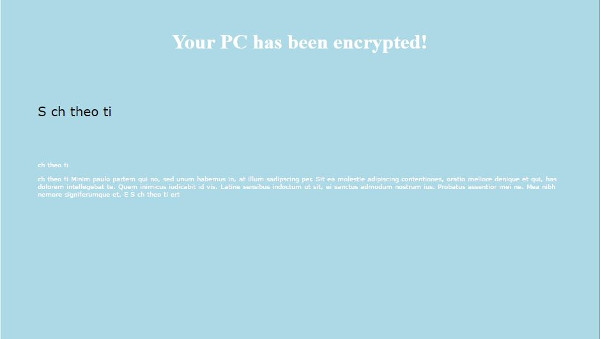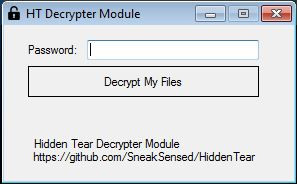RANSOM_HIDDENTEARDECRYPTOR.A
Trojan.Win32.Agent.neydao (Kaspersky), Trojan.MSIL.Filecoder (Ikarus)
Windows


Threat Type: Trojan
Destructiveness: No
Encrypted: No
In the wild: Yes
OVERVIEW
This Trojan arrives on a system as a file dropped by other malware or as a file downloaded unknowingly by users when visiting malicious sites.
TECHNICAL DETAILS
Arrival Details
This Trojan arrives on a system as a file dropped by other malware or as a file downloaded unknowingly by users when visiting malicious sites.
Autostart Technique
This Trojan adds the following registry entries to enable its automatic execution at every system startup:
HKEY_CURRENT_USER\Software\Microsoft\
Windows\CurrentVersion\Run
Crypt = %User Startup%\HTCryptor.exe
It drops the following file(s) in the Windows Common Startup folder to enable its automatic execution at every system startup:
- %User Startup%\HTCryptor.exe - Copy of itself
(Note: %User Startup% is the current user's Startup folder, which is usually C:\Documents and Settings\{user}\Start Menu\Programs\Startup on Windows 2000 and XP, and C:\Documents and Settings\{User name}\Start Menu\Programs\Startup on Windows Vista, 7, and 8.)
Dropping Routine
This Trojan drops the following files:
- %User Startup%\HTDecryptor.exe - Decryptor Module
- %Desktop%\HTDecryptor.exe - Decryptor Module
- %Start Menu%\HTDecryptor.exe - Decryptor Module
- %Program Files%\HTDecryptor.exe - Decryptor Module
- %User Profile%\Videos\Decryptor.exe - Decryptor Module
- %User Profile%\Pictures\HTDecryptor.exe - Decryptor Module
- %User Profile%\Music\HTDecryptor.exe - Decryptor Module
- %User Startup%\message.exe - lock screen message
(Note: %User Startup% is the current user's Startup folder, which is usually C:\Documents and Settings\{user}\Start Menu\Programs\Startup on Windows 2000 and XP, and C:\Documents and Settings\{User name}\Start Menu\Programs\Startup on Windows Vista, 7, and 8.. %Desktop% is the desktop folder, where it usually is C:\Documents and Settings\{user name}\Desktop in Windows 2000, Windows Server 2003, and Windows XP (32- and 64-bit); C:\Users\{user name}\Desktop in Windows Vista (32- and 64-bit), Windows 7 (32- and 64-bit), Windows 8 (32- and 64-bit), Windows 8.1 (32- and 64-bit), Windows Server 2008, and Windows Server 2012.. %Start Menu% is the Start Menu folder, where it usually is C:\Documents and Settings\{user name}\Start Menu on Windows 2000, Windows Server 2003, and Windows XP (32- and 64-bit); C:\Users\{user name}\AppData\Roaming\Microsoft\Windows\Start Menu on Windows Vista (32- and 64-bit), Windows 7 (32- and 64-bit), Windows 8 (32- and 64-bit), Windows 8.1 (32- and 64-bit), Windows Server 2008, and Windows Server 2012.. %Program Files% is the Program Files folder, where it usually is C:\Program Files on all Windows operating system versions; C:\Program Files (x86) for 32-bit applications running on Windows 64-bit operating systems.. %User Profile% is the current user's profile folder, which is usually C:\Documents and Settings\{user name} on Windows 2000, XP, and Server 2003, or C:\Users\{user name} on Windows Vista and 7.)
Other Details
This Trojan connects to the following URL(s) to check for an Internet connection:
- http://www.websitetest.com/
It encrypts files with the following extensions:
- .txt
- .doc
- .docx
- .log
- .msg
- .odt
- .pages
- .rtf
- .tex
- .wpd
- .wps
- .csv
- .dat
- .ged
- .key
- .keychain
- .pps
- .ppt
- .pptx
- .sdf
- .tar
- .tax2014
- .tax2015
- .vcf
- .xml
- .aif
- .iff
- .m3u
- .m4a
- .mid
- .mp3
- .mpa
- .wav
- .wma
- .3g2
- .3gp
- .asf
- .avi
- .flv
- .m4v
- .mov
- .mp4
- .mpg
- .rm
- .srt
- .swf
- .vob
- .wmv
- .3dm
- .3ds
- .max
- .obj
- .bmp
- .dds
- .gif
- .jpg
- .png
- .psd
- .tga
- .thm
- .tif
- .tiff
- .yuv
- .ai
- .eps
- .ps
- .svg
- .indd
- .pct
- .xlr
- .xls
- .xlsx
- .accdb
- .db
- .dbf
- .mdb
- .pdb
- .sql
- .dwg
- .dxf
- .asp
- .aspx
- .cer
- .cfm
- .csr
- .css
- .htm
- .html
- .js
- .jsp
- .php
- .rss
- .xhtml
- .7z
- .cbr
- .deb
- .gz
- .pkg
- .rar
- .rpm
- .sitx
- .tar.gz
- .zip
- .zipx
- .bin
- .cue
- .dmg
- .iso
- .mdf
- .toast
- .vcd
- .class
- .cpp
- .cs
- .dtd
- .fla
- .java
- .lua
- .pl
- .py
- .sh
- .sln
- .swift
- .vb
- .vcxproj
- .xcodeproj
- .bak
- .tmp
- .crdownload
- .ics
- .msi
- .part
- .torrent
It renames encrypted files using the following names:
- {Original filename and extension}.locked
It does the following:
- It disables the firewall using the following command:
- netsh firewall set opmode disable
NOTES:
The ransomware displays the following lock screen:

The ransomware displays the following window as its decryptor module:

SOLUTION
Step 1
Before doing any scans, Windows XP, Windows Vista, and Windows 7 users must disable System Restore to allow full scanning of their computers.
Step 2
Note that not all files, folders, and registry keys and entries are installed on your computer during this malware's/spyware's/grayware's execution. This may be due to incomplete installation or other operating system conditions. If you do not find the same files/folders/registry information, please proceed to the next step.
Step 3
Restart in Safe Mode
Step 4
Delete this registry value
Important: Editing the Windows Registry incorrectly can lead to irreversible system malfunction. Please do this step only if you know how or you can ask assistance from your system administrator. Else, check this Microsoft article first before modifying your computer's registry.
- In HKEY_CURRENT_USER\Software\Microsoft\Windows\CurrentVersion\Run
- Crypt = "%User Startup%\HTCryptor.exe"
- Crypt = "%User Startup%\HTCryptor.exe"
Step 5
Search and delete this file
- %User Startup%\HTDecryptor.exe
- %Desktop%\HTDecryptor.exe
- %Start Menu%\HTDecryptor.exe
- %Program Files%\HTDecryptor.exe
- %User Profile%\Videos\Decryptor.exe
- %User Profile%\Pictures\HTDecryptor.exe
- %User Profile%\Music\HTDecryptor.exe
- %User Startup%\message.exe
Step 6
Restart in normal mode and scan your computer with your Trend Micro product for files detected as RANSOM_HIDDENTEARDECRYPTOR.A. If the detected files have already been cleaned, deleted, or quarantined by your Trend Micro product, no further step is required. You may opt to simply delete the quarantined files. Please check this Knowledge Base page for more information.
Step 7
Restore encrypted files from backup.
NOTES:
Enable disabled firewall using the following command prompt:
Did this description help? Tell us how we did.

